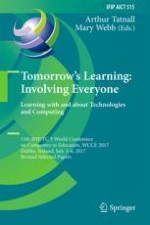2017 | Buch
Tomorrow's Learning: Involving Everyone. Learning with and about Technologies and Computing
11th IFIP TC 3 World Conference on Computers in Education, WCCE 2017, Dublin, Ireland, July 3-6, 2017, Revised Selected Papers
herausgegeben von: Dr. Arthur Tatnall, Mary Webb
Verlag: Springer International Publishing
Buchreihe : IFIP Advances in Information and Communication Technology
